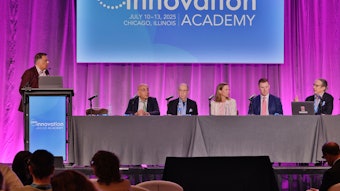Strive to thrive
Panelists shared advancements in dermatology practice processes and regulations as well as advice for innovations and implementations.

Fresh findings, critical updates, and new resources were served up in Thursday’s session, C001 – Navigating Practice Management in Dermatology: Insights and Innovations. Session directors Alexandra Flamm, MD, FAAD, and George Han, MD, PhD, FAAD, gathered presenters proficient in aspects of operating a dermatology practice, including administration, implementation, coding, payments, and technology.
“Practice management is a key component to effectively caring for patients, supporting staff, and ensuring a thriving career,” said Dr. Flamm, who is associate professor of dermatology and residency program director at NYU Grossman School of Medicine. “This is an area that is constantly and often rapidly changing; therefore, understanding what is new and updated is of upmost importance.”
Throughout the session, panelists echoed this message that patients are the priority, but to take care of them, physicians must first care for the well-being of themselves and their profession.
“This session will help physicians improve their practice workflows, so they can spend less time on administrative tasks and challenges and more time with their patients,” said Dr. Han, who is associate professor of dermatology at the Icahn School of Medicine at Mount Sinai in New York City.
Automating approvals
The prior authorization (PA) process and requirements have become a significant burden to physicians and practices across the country, said Drew A. Emge, MD, MSc, FAAD. Fortunately, there are tools and tactics that dermatologists can employ to streamline the task, decrease effort, and prevent delays in patient care.
 Drew A. Emge, MD, MSc, FAAD
Drew A. Emge, MD, MSc, FAAD
“Dermatologists can spend hours navigating complex, inconsistent, and ever-changing PA processes, which detracts from direct patient care and contributes to professional frustration and burnout,” Dr. Emge said. “We can leverage the Practice Management Center to create a more effective and patient-centered practice environment.”
These resources, which are developed and maintained by dermatology experts, assist in navigating the complex, changing landscape of prior authorizations, insurance regulations, and other operational processes and challenges. Investing in technology to automate steps and training to adopt a team-based care model adds short- and long-term value, said Dr. Emge.
Taking the pain out of coding
Several other speakers also spoke of the value of investing time in understanding the non-clinical side of practice management, in particular coding. Physicians aren’t necessarily trained on the ins and outs of coding and reimbursement, and keeping up with this part of the business can be overwhelming after a long day of seeing patients.
Faith C. McNicholas, RHIT, CPC, CPCD, PCS, CDC, the Academy’s senior manager of coding and reimbursement, zeroed in on the latest payer payment policies, coding changes, and regulatory trends impacting dermatology practices. She also provided guidance to minimize denials and prevent common pitfalls that can lead to audits.
 Faith C. McNicholas, RHIT, CPC, CPCD, PCS, CDC
Faith C. McNicholas, RHIT, CPC, CPCD, PCS, CDC
Christopher M. DiMarco, MD, FAAD, associate professor and clinician educator at the Warren Alpert Medical School of Brown University in Rhode Island, agreed that familiarity with coding is critical to keep a practice surviving and, hopefully, thriving. He suggested that a combination of accurate coding, strategic negotiation, and trimming of unnecessary costs can help ease the burden of running a practice in the current landscape.
Both Dr. DiMarco and McNicholas recommended a step-by-step approach to implementing new systems, skills, and regulations, with emphasis on:
- Full practice participation
- Transparent communication and feedback
- Hands-on learning
- Recurring reinforcement
- Automated tools
Adapting to the changing quality improvement landscape
Alina G. Bridges, DO, FAAD, instructed attendees on the Quality Payment Program (QPP) to assist colleagues in navigating critical changes for 2025. Dr. Bridges is associate professor and director of dermatopathology and cutaneous immunodermatology at the Donald and Barbara Zucker School of Medicine at Hofstra/Northwell in New York. Some of the recent revisions she highlighted include:
- A Dermatological Care MVP that combines diverse measures into a single pathway.
- An exchange of the outdated melanoma continuity of care measure (137) for a new melanoma recurrence measure.
- Requirements to maintain a 75-point threshold.
- Additional updates to the data completeness criteria and cost scoring methodologies.
 Alina G. Bridges, DO, FAAD
Alina G. Bridges, DO, FAAD
“These programs are complex, evolving, and disproportionately difficult for smaller, independent practices to manage alone,” Dr. Bridges said. “Falling behind on policy updates can lead to financial penalties and lost opportunities, even if the programs themselves are not ideal. Staying informed is a form of self-protection in a system that increasingly prioritizes compliance over care.”
Tools like the Academy’s DataDerm™ registry can help reduce manual effort and increase productivity. Preparation is also key, Dr. Bridges said, to mitigate disruption and deficit, as well as the power to pivot and remain flexible.
“Just because a measure is required doesn’t mean it reflects the quality or value of your care,” she said. “Your implementation strategy should be realistic, efficient, and protect the integrity of your clinical practice.”
Decoding technology and AI
Dermatology and other specialties across the health care industry have had to embrace a lot of technological advancements in the last five years, largely due to the COVID-19 pandemic. Tools like telemedicine and online portals have helped expand patient accessibility, said Elizabeth Jones, MD, FAAD, but they are still being underused and undervalued.
 Elizabeth Jones, MD, FAAD
Elizabeth Jones, MD, FAAD
“We have a national shortage of dermatologists with clustering in urban areas. Dermatologists are in high demand but under immense pressure in their clinics with decreasing reimbursement, increasing administrative tasks, and burnout,” said Dr. Jones. “To offset these pressures, we have technological tools that can triage and schedule more efficiently to offset shortages of staff or office resources and enable us to provide care over a greater regional spread using teledermatology.”
Practical recommendations she mentioned were identifying follow-up visits for certain conditions to be teledermatology appointments and reserving all virtual visits for the end of the day to wind down clinic.
James S. Taylor, MD, FAAD, outlined various applications and considerations of technology advancements as well as their implications. In-office uses range from leveraging AI in clinical decision-making to utilizing it in documentation. He also referenced AI chatbots to support patient communication.
“It is important to know the basics of AI since your patients may be using it in advance of visits to research the diagnosis and treatment of their medical problems,” said Dr. Taylor, who is clinical professor of dermatology at Cleveland Clinic.
Aside from the litany of AI offerings and benefits, physicians should be careful in the selection and functionality of technology, Dr. Taylor said. AI programs present implications for patient safety and must be carefully vetted for scientific evidence and rigor.
Ultimately, Dr. Jones said firsthand experience with innovations enables dermatologists to better advocate for future enhancements to products, procedures, and policies.
“It is important for dermatologists to value their voice and knowledge through leadership in creating, advising, and implementing innovation,” she said. “Adaptability in practice management is an essential part of our careers.”











